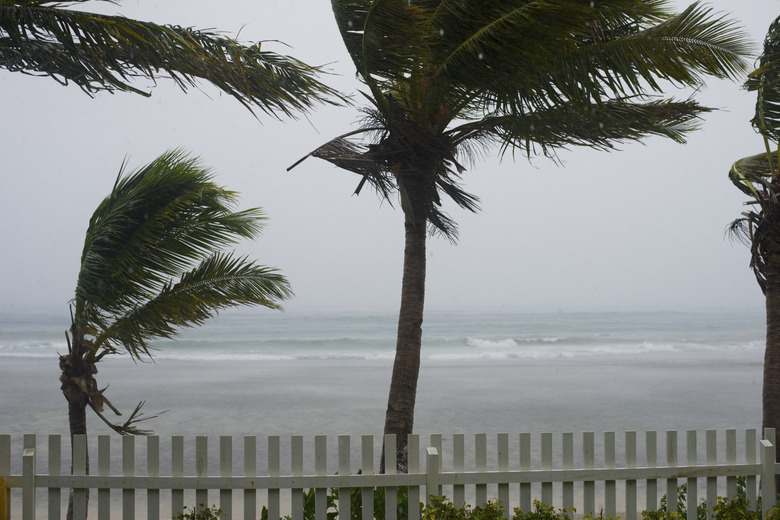Types Of Typhoons
Some of Earth's most destructive forces, typhoons can never strike the United States – but only because of semantics. "Hurricane," "cyclone" and "typhoon" are names for the same type of storm – a tropical cyclone – but the name "typhoon" only refers to storms that form between 180 and 100 degrees East longitude in the Western Pacific. Hurricanes are the name for tropical cyclones that occur in the Northeast Pacific and Atlantic. Several types of typhoons form that cause varying degrees of destruction.
Birth of a Typhoon
Birth of a Typhoon
Typhoons need warm water near the equator to form. As solar energy heats the water, an area of low pressure forms near the ocean's surface as warm, moist air rises from the surface. Air with higher pressure in the surrounding area moves into the low-pressure area.
When these winds combine with forces created by the earth's rotation, the result is a rotating storm (counterclockwise in the Northern Hemisphere; clockwise in the Southern Hemisphere). As winds increase and clouds spin, a typhoon acquires an eye: a central low-pressure region that's clear and calm.
Interestingly, while they require warm equatorial or subtropical waters to form, typhoons don't arise right along the equator. That's because around this midsection of the planet the Coriolis force – the influence of the planet's rotation on air movement – is barely evident.
The veering of winds caused by the Coriolis force causes air flowing into a low-pressure center to spiral, helping create a typhoon. At the equator, with the Coriolis force basically nonexistent, air can move straight into a low-pressure center, which keeps it from intensifying and prevents rotation.
Category 5 Typhoons: Pure Devastation
Category 5 Typhoons: Pure Devastation
With values ranging from 1 to 5, the Saffir-Sampson Hurricane Wind scale rates typhoons based on their wind speeds and places them into typhoon categories. A category 5 typhoon can swirl with wind speeds equal to or greater than 157 miles per hour. At those velocities, catastrophic damage occurs with power outages lasting up to months and large numbers of framed homes lying in ruins.
People may also be unable to live in the ravaged area for periods ranging from weeks to months. Meteorologists call tropical clones in the western North Pacific super typhoons when sustained winds exceed 150 miles per hour.
Danger from Category 3 and 4 Storms
Danger from Category 3 and 4 Storms
Not as destructive as the category 5 versions, category 4 typhoons still carry the "catastrophic damage" label because their sustained winds are 130 to 156 miles per hour. Winds cause severe damage to well-built frame homes, and fallen power poles and trees isolate neighborhoods. With wind speeds ranging from 111 to 129 miles per hour, category 3 typhoons create devastating damage. Regions may lose water and electricity for days to weeks.
Categories 1 and 2: Still Destructive
Categories 1 and 2: Still Destructive
A category 2 typhoon storm can cause extensive damage – even though its 96- to 110-mile-per-hour winds are lower than those in category 3 storms. When a category 2 hits, trees with shallow roots break and power outages can last from days to weeks.
At the bottom of the scale, you find category 1 typhoons that cause some damage – they have winds of 74 to 95 miles per hour. Power can go out for days, large tree branches snap and winds may bring down trees that have shallow roots.
The Power of Storm Surges
The Power of Storm Surges
Super Typhoon Haiyan, a category 5 storm with winds reaching 195 miles per hour, killed thousands of people in the Philippines in 2013. Typhoon Haiyan's storm surge displaced hundreds of thousands of people with water reaching about eight feet – higher in some locations, according to reports.
A storm surge is an unusually high level of water caused by strong winds that drive it onto shore. These surges are very dangerous and can sweep away entire neighborhoods.
References
- National Public Radio: Which Is It? Hurricane, Typhoon or Tropical Cyclone?
- National Aeronautics and Space Administration: How Do Hurricanes Form?
- CNN: Super Typhoon Haiyan, Strongest Storm of 2013, Hits Philippines
- National Weather Service – National Hurricane Center: Saffir-Simpson Hurricane Wind Scale
- The New York Times: Mapping the Destruction of Typhoon Haiyan
- National Weather Service – National Hurricane Center: Storm Surge Overview
Cite This Article
MLA
Lee, Kevin. "Types Of Typhoons" sciencing.com, https://www.sciencing.com/types-typhoons-6130158/. 30 September 2021.
APA
Lee, Kevin. (2021, September 30). Types Of Typhoons. sciencing.com. Retrieved from https://www.sciencing.com/types-typhoons-6130158/
Chicago
Lee, Kevin. Types Of Typhoons last modified March 24, 2022. https://www.sciencing.com/types-typhoons-6130158/
